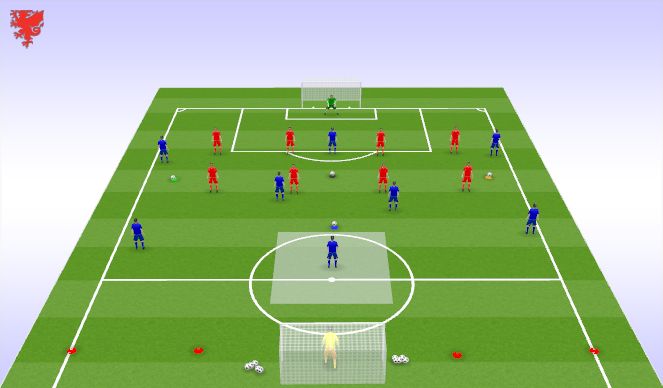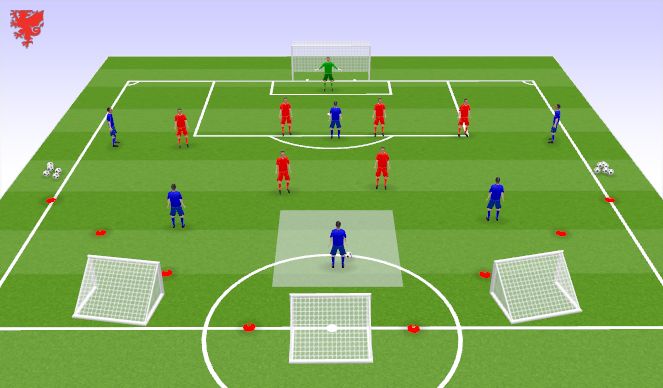Football/Soccer Session (Academy Sessions): Defending the box in a 4-4-2 (Start Time: 25-Mar-2023 09:15h)

Profile Summary

| Name: | James Pritty |
|---|---|
| City: | Warrington |
| Country: | United Kingdom |
| Membership: | Adult Member |
| Sport: | Football/Soccer |
Description
Organisation (Practice Layout & Transition)

See the guidance at the top of this page to understand why you are not seeing interactive Football/Soccer images.

Screen 2
Primary Focus - SSG practice on defending the box. Understand when and how to minimise space, deal with crosses/shots & protect space centrally in the defensive third. Main focus is defending in wide areas.
Organisation - Players bibbed up in and in positions as shown above.
Area Size - Just over half a pitch.
Timings - 3 blocks of 4 minutes.
Explanation
Reds will defend in a 1-4-4, blues will attack in a 3-2-3. Blues will start with the ball either from the GK or the coach will feed one in at random. They are looking to score in the reds goal. If the reds win it they have 10 seconds to counter and go and score. Blue CB to stay within the shaded area in possession and play max 3 touches.
Adaptations:
Progressions
In blocks 2&3, when the coach calls a certain coloured cone the current ball in play should be knocked out and play will resume from the ball placed on the called colour.
Regressions
Coach can give the ball to the reds to start the attack.
Challenges, Conditions or Targets:
1: Protect the central areas and force wide.
2: Delay the attack.
3: Stop crosses/minimise box entries.
Key Points
1. Cover and balance/moving as a unit - Between 8m and 10m between the two banks of 4. Should shift as a unit and show cover and balance if a player goes to put pressure on the ball (piece of string defending). Team should be narrow to force play outside. If a cross is going to come in full back should be closing this down, CB 1 near post, CB 2 centre of goal, and other full back should be in line with the back post.
2. Delay - As the point of attack changes the defender closest must try to delay the attacker to enable support to come across and help defend. Shutdown, slowdown, showdown or quick-slow-sideways-low to help with 1v1 defending to ensure play remains on the outside.
3. Double up in wide areas - As player joins the 1v1 defender they should double up inside. Stops the wide player coming inside. Also allows covering play to take over if original defender needs to go with runner goes around the outside.
4. Recovery runs - Defenders making recovery runs as the point of attack changes should direct these runs inside the width of the goal.
5. Awareness of runners - Full backs should always be checking their shoulder on a second by second basis.
6. Transition to attack.
Interventions - Concurrent, Terminal, Walk Through, Coaching Process.
Problem
1. Striker drops off into false 9 role.
2. Reds lose the ball when counter attacking - wide player comes and plays in the 10 during the attack, lose the ball and now outnumbered in wide area on transition to defence.
3. Extra player up against two centre backs (two opposition strikers).
Solution
1. CB goes with him whilst other three defenders narrow up and close the gaps to stop the space for wide players in behind. Or if he drops in front of midfield communicate for one of them to go with him. Other 3 midfielders must then narrow and cover.
2. Make recovery runs as quickly as possible. Nearest CM covers wide area (defend to delay) as wide player makes recovery run. At the same time other central midfielder will come across for support behind player going to the ball. Back 4 narrows to force play wide.
3. Create a back 5. Dependent on which side the ball is on, full back will narrow to make 3 CB and wide midfielder should drop to full back to create numerical advantage for defenders in the box.
How do we measure success?
Goals scored/opportunities created by opposition. Players understanding of positioning dependent on where the ball is and how to best prevent the opposition from scoring.









 Play animation
Play animation Play step-by-step
Play step-by-step Repeat (toggle)
Repeat (toggle) Full Screen
Full Screen Pause
Pause Stop
Stop
Screen 1 (10 mins)
Primary Focus
Specific practice on defending the box. Understand when and how to minimise space, deal with crosses/shots & protect space centrally in the defensive third. Main focus is defending in wide areas.
Organisation
Players bibbed up in and in positions as shown above.
Area Size
Full half - low wide areas cut off.
Timings
2 blocks of 3 minutes.
Explanation
Set up as shown, blues in a 3-3 shape with two wide forwards, reds defending in a 4-2. The blues will be fed a ball by the coach and will attack vs the reds. To score the blues must score in the big goal past the GK, reds can score in any of the mini goals if they win possession but this must be done within 8 seconds. No player is allowed in the coned off area where the mini goals are. Blue CB (shaded area) must stay in zone and play off 3 touches.
Scoring System
Block 1
- Reds score by finishing in mini goals within 8 seconds of winning the ball.
- Blues score by finishing in big goal. 1 goal if it comes from a cross/wide area. 2 goals if they play through centrally (within width of the penalty area).
Block 2
- Reds score by finishing in mini goals within 8 seconds of winning the ball.
- Blues score by finishing in big goal. 1 goal if it comes from a central area. 2 goals if the goal comes from wide play.
Adaptations (Progressions & Regressions):
Progressions
Take away the coned zone, allowing attackers to drop off to force the defenders to step out and create space for switch of play or ball in behind.
Regressions
Make the pitch narrower.
Challenges, Conditions or Targets:
Block 1: Protect the central areas and force wide.
Block 2: Stop crosses/minimise box entries.
Key Points
Block 1: Compact/move as a unit, force play wide through body shape when closing down, distances between units, angle of support, preventing shooting opportunities, anticipation (triggers).
Block 2: Compact as a unit, block the line of the cross, body shape to force play wide, anticipation, box defending (body shape of central players when the ball is wide).
Interventions
Concurrent, Terminal, Walk Through, Coaching Process.
Problem
1. Striker drops off into false 9 role.
2. Defenders become unorganised and out of shape when pressing midfield players (1 red CM gets taken out of the game).
3. Wide player gets in behind full back who has pressed to early to create gap.
Solution
1. CB goes with him whilst other three defenders narrow up and close the gaps to stop the space for wide players in behind.
2. Back 4 become slightly more compact to support lone CM to force play wide. Emphasis now on the quality of defending in wide area. Other option is for a defender to step out, other 3 defenders must show cover and balance.
3. Nearest CB comes across with other full back shifting over to play as other CB. CM must now cover far post if a player is there. More threat of a pull back to the edge so players must be ready to get out to the ball and close down (body shape must be correct as they must be able to see both players and the ball).
How do we measure success?
Goals scored/opportunities created. Players understanding of positioning dependent on where the ball is and how to best prevent the opposition from scoring.